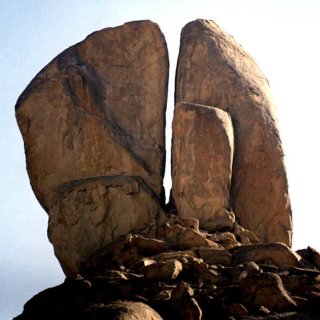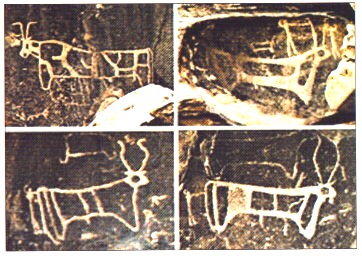Gene Edward Veith has a critical reviow of what some people are maintaining that they have found the “real” Mt. Sinai in Saudi Arabia. And the discovery is accompanied with evidence of Biblical history, including the possibility of actual artifacts of miracles described in Exodus. This is from a secular blogsite. I’ll intersperse some pictures of what the account refers to, which are so mindblowing that they nearly defy belief :
Dr. Veith says:Dr. Moller points out that the site at Nuweiba he identifies as the Red Sea crossing point has an underwater land bridge, upon which damaged chariot parts and bones remain, engulfed in coral.
The top of Jabal al-Lawz, the alleged real Mt. Sinai, is black, as if burned from the sky as described in Exodus 19:18, where it says “the Lord descended upon it in fire.” This feature sets it apart from all the other surrounding mountains which do not have darkened tops. The BASE Institute’s film shows Cornuke, who snuck onto the mountain, examining the rocks he cracked, observing that they are not merely black rocks and that only the outside had become darkened by whatever had occurred at the site. Moller has a photo of one of these rocks, which he identifies as “obsidian or volcanic glass, a mineral formed at high temperatures.”
One of the greatest — and most doubted — miracles of the Exodus is the story about God instructing Moses to hit a large rock with his rod, which resulted in a flow of water for the Hebrews to drink from. Near Jabal al-Lawz is a large rock, standing about 60 feet high, split down the middle. The edges of the split and the rock underneath it have become smooth, as if a stream of water had poured forth from the rock, creating a river. Given the annual rainfall in Saudi Arabia and the fact that the erosion is only present on that rock and no other ones in the surrounding area, it’s hard to find a plausible explanation for this remarkable find.
A site matching the description of the altar of the golden calf is also at this site. As the Biblical story goes, while Moses was away for 40 days on Mt. Sinai, the Hebrews created an altar with a golden calf on top of it, which they worshiped. Moses, incensed at the betrayal, crushed the calf into smithereens. A large altar with inscriptions of Egyptian bulls engraved onto it is also near Mt. Sinai, making it the only location in Saudi Arabia to have such inscriptions. Moller notes in his book that “one block of stone at the altar had a slight depression and after a brief shower something glistened at the bottom, which turned out to be small flakes of gold. This rock could well have been the place where Moses ground the golden calf into powder.”
This is just scratching the surface. The 12 wells of Elim, the altar constructed by Moses after the defeat of the Amalekites, evidence of large encampments, the boundary markers and stone pillars the Bible says were placed around Mt. Sinai, and several other sites identified in the Old Testament are located. Simply put, everything that the Bible indicates should be there is present. The researchers even describe how the locals refer to the site as “Moses’ Mountain” and it is common knowledge that Moses passed through the area.
I’ve got to say, though, I feel suspicious. The books came out in the early 2000s, do not seem to be from mainline publishers (except for one from Broadman & Holman), and are already out of print. Why is this work from a decade ago being brought up now? Why hasn’t this already made an impact if it is so compelling? Still, bogus or real, it’s intriguing. Does anyone know any more about this?
UPDATE: Here is a critical review, though it doesn’t deal with all of the questions.
The mountain is called Jabal al-Lawz. You can see it on Google Earth.




No comments:
Post a Comment